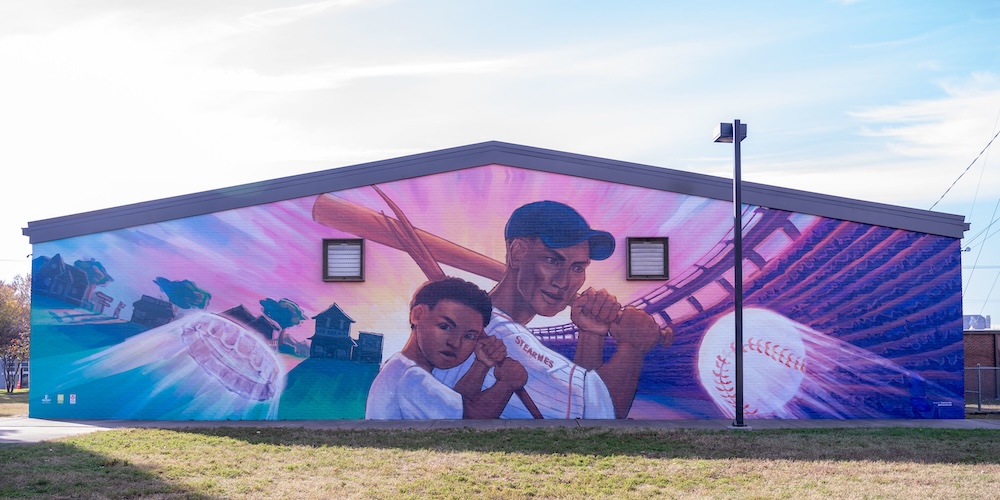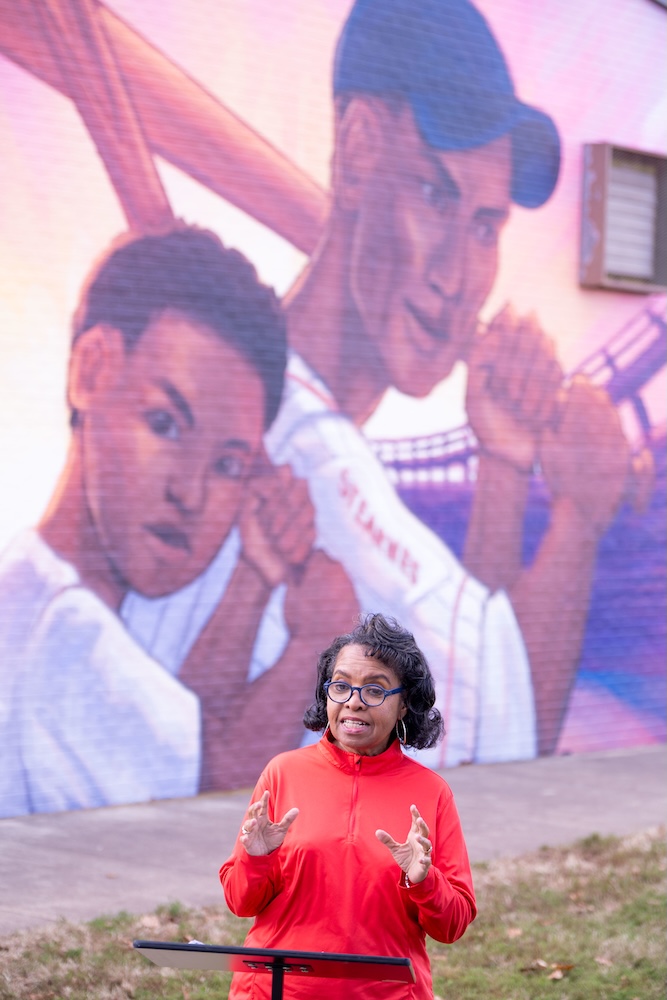Collaboration between Belmont’s Watkins College of Art, Metro Arts and Metro Parks brings history and hope to life at Rose Park
When Belmont illustration major Joanna Wu first learned about Nashville’s Negro Baseball League, she knew little about the players who shaped the sport’s history. But after hearing stories from Dr. Harriet Kimbro Hamilton, daughter of Nashville Negro Leagues star Henry Kimbro, Wu found inspiration in the community’s resilience and creativity.
That spirit now lives on through her design for a new community mural at E.S. Rose Park/Easley Recreation Center, created in partnership with Metro Arts, Metro Parks and the Watkins College of Art.

Funded through a $20,000 Metro Arts grant, the project invited Watkins illustration students to design a mural that honors the area’s history and reflects the identity of the Edgehill community. After months of collaboration between students, Metro partners and neighborhood members, Wu’s design was selected for installation, transforming a wall near Rose Park into a celebration of heritage, perseverance and creativity.
Kimbro Hamilton said the mural is powerful because it shines a light on a community and a legacy that shaped Nashville long before the present day.
“It celebrates community –– a community that has lasted and come through many obstacles,” she said. “It reflects the Negro Leagues of a time when men were not allowed to play baseball in the white league because of the color of their skin. That’s an important story to tell.”
A Story of Determination

Wu’s design draws on a story shared by Dr. Kimbro Hamilton about her father’s childhood and how kids in the neighborhood once played baseball using sticks and bottle caps when they were excluded from local leagues. “I wanted to convey that anything is possible,” Wu said. “Many things we know today exist because people found a way to overcome challenges. This mural is like a time frame showing what’s achievable.”
Kimbro Hamilton added that this story reflects a wider history of ingenuity and persistence. “Baseball was the most important sport in the Black community,” she said.
“It became popular because it was easy to play, competitive and fun. Something the whole country was embracing. Our community was no different.”
Look closely and the mural reveals the spirit of Edgehill itself: historic neighborhood buildings and familiar landmarks woven subtly into the background as a tribute to the place that shaped so much of the story. “I’m most excited for people to notice that this mural is for Edgehill,” Wu explained. “It’s a small glimpse into history.”
Preserving Local Heroes

In addition to honoring the Edgehill community, the mural features one of Nashville’s greatest baseball legends: Norman “Turkey” Stearnes, a Nashville native and star of the Negro National League. Stearnes, known for his consistent hitting power and speed, was the first Tennessean to be inducted into the National Baseball Hall of Fame in 2000.
Kimbro Hamilton said she was moved to see Stearnes represented so prominently. “I am glad they chose this design. It is symbolic,” she reflected. “I love that they have Norman ‘Turkey’ Stearnes and then a little boy. It’s a connection we should continue. What was done here long ago should continue with the next generation.”
While the mural honors Stearnes visually, Wu’s creative inspiration began with stories of Kimbro Hamilton’s father, Henry Kimbro — another major figure in Nashville’s Negro League history whose legacy is deeply tied to Edgehill. “He wasn’t a flashy guy, but for 10 years he hit over .300. That’s significant,” Dr. Kimbro Hamilton said. “He played against Josh Gibson, against ‘Cool Papa’ Bell (the names everyone knows), and he held his own.”
When asked what players of that era might think if they could see the mural today, she didn't hesitate. “I think they would be very proud. They took seriously that they were doing something bigger than themselves,” she reflected. “This would be part of their legacy — that Nashville is still remembering them.”
Wu’s composition captures both the grit and grace of an earlier era, but its purpose looks forward. “Seeing it actually up on the wall feels surreal,” she said. “It’s different when words become reality. I really hope the kids near the park will feel inspired by it.”

A Lesson Beyond the Classroom
The project also reflects how Watkins prepares students to merge creativity with community. “Watkins is really good at knowing when to be strict and when to let us go crazy with creativity,” Wu said. “That balance helps us learn to express ourselves in ways that make sense to the people viewing our work.”
Wu added that the experience gave her a deeper appreciation for what art can do beyond galleries and screens. “My future goals haven’t changed, but I think I gained a new appreciation for how art can tie people together,” she said. “It opened my eyes to what art can do for community.”

As a historian and educator, Kimbro Hamilton emphasized the power of giving students access to local stories that feel close to home.
“I show them faces. I show them uniforms. I tell their stories so it becomes real,” she explained. “This didn’t just happen up north or out in California; it happened here. And people need to know that story.”
The mural was officially dedicated at a ribbon cutting, Nov. 13, celebrating the collaboration between Belmont students, Metro partners and the Edgehill community that brought this vibrant piece of history to life.
Learn More
Study Illustration with Purpose

